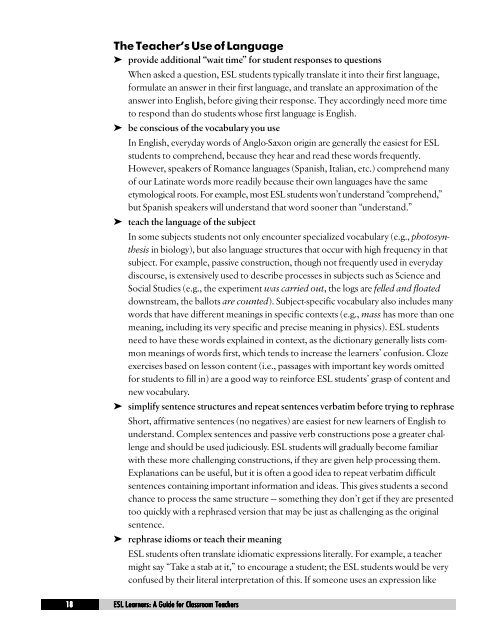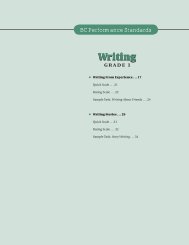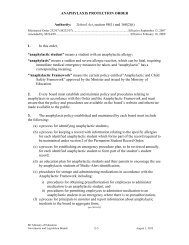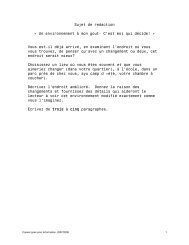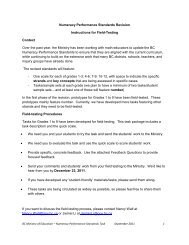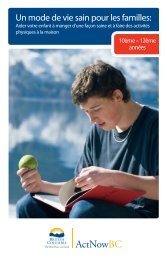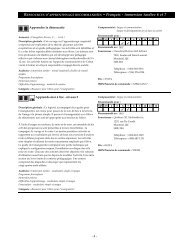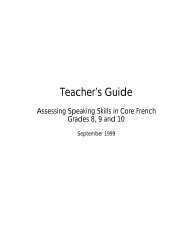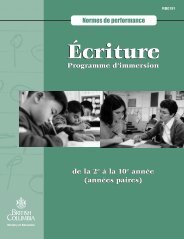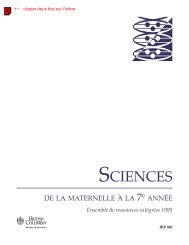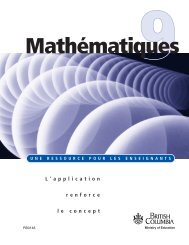A Guide for Classroom Teachers - Education
A Guide for Classroom Teachers - Education
A Guide for Classroom Teachers - Education
Create successful ePaper yourself
Turn your PDF publications into a flip-book with our unique Google optimized e-Paper software.
18<br />
18<br />
The Teacher’s Use of Language<br />
➤ provide additional “wait time” <strong>for</strong> student responses to questions<br />
When asked a question, ESL students typically translate it into their first language,<br />
<strong>for</strong>mulate an answer in their first language, and translate an approximation of the<br />
answer into English, be<strong>for</strong>e giving their response. They accordingly need more time<br />
to respond than do students whose first language is English.<br />
➤ be conscious of the vocabulary you use<br />
In English, everyday words of Anglo-Saxon origin are generally the easiest <strong>for</strong> ESL<br />
students to comprehend, because they hear and read these words frequently.<br />
However, speakers of Romance languages (Spanish, Italian, etc.) comprehend many<br />
of our Latinate words more readily because their own languages have the same<br />
etymological roots. For example, most ESL students won’t understand “comprehend,”<br />
but Spanish speakers will understand that word sooner than “understand.”<br />
➤ teach the language of the subject<br />
In some subjects students not only encounter specialized vocabulary (e.g., photosynthesis<br />
in biology), but also language structures that occur with high frequency in that<br />
subject. For example, passive construction, though not frequently used in everyday<br />
discourse, is extensively used to describe processes in subjects such as Science and<br />
Social Studies (e.g., the experiment was carried out, the logs are felled and floated<br />
downstream, the ballots are counted). Subject-specific vocabulary also includes many<br />
words that have different meanings in specific contexts (e.g., mass has more than one<br />
meaning, including its very specific and precise meaning in physics). ESL students<br />
need to have these words explained in context, as the dictionary generally lists common<br />
meanings of words first, which tends to increase the learners’ confusion. Cloze<br />
exercises based on lesson content (i.e., passages with important key words omitted<br />
<strong>for</strong> students to fill in) are a good way to rein<strong>for</strong>ce ESL students’ grasp of content and<br />
new vocabulary.<br />
➤ simplify sentence structures and repeat sentences verbatim be<strong>for</strong>e trying to rephrase<br />
Short, affirmative sentences (no negatives) are easiest <strong>for</strong> new learners of English to<br />
understand. Complex sentences and passive verb constructions pose a greater challenge<br />
and should be used judiciously. ESL students will gradually become familiar<br />
with these more challenging constructions, if they are given help processing them.<br />
Explanations can be useful, but it is often a good idea to repeat verbatim difficult<br />
sentences containing important in<strong>for</strong>mation and ideas. This gives students a second<br />
chance to process the same structure — something they don’t get if they are presented<br />
too quickly with a rephrased version that may be just as challenging as the original<br />
sentence.<br />
➤ rephrase idioms or teach their meaning<br />
ESL students often translate idiomatic expressions literally. For example, a teacher<br />
might say “Take a stab at it,” to encourage a student; the ESL students would be very<br />
confused by their literal interpretation of this. If someone uses an expression like<br />
ESL ESL Learners: Learners: A A <strong>Guide</strong> <strong>Guide</strong> <strong>for</strong> <strong>for</strong> <strong>Classroom</strong> <strong>Classroom</strong> <strong>Teachers</strong><br />
<strong>Teachers</strong>


